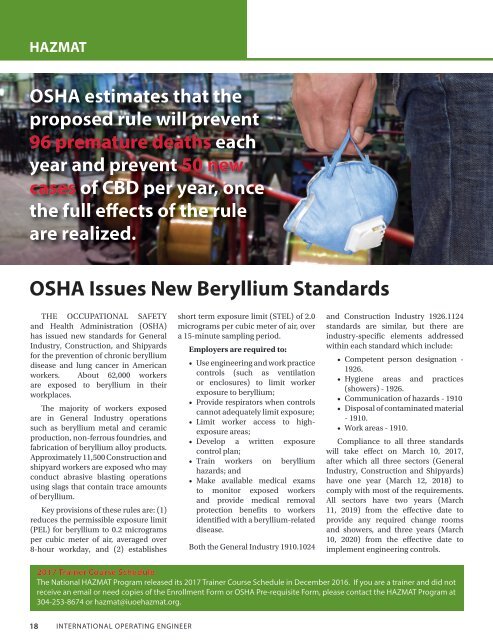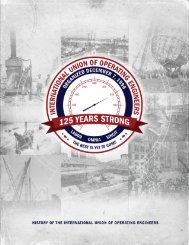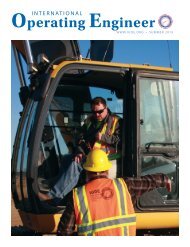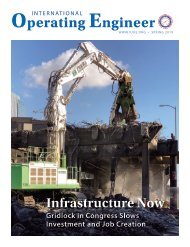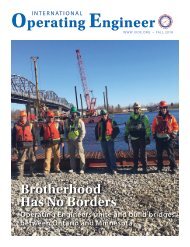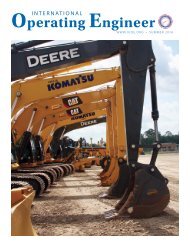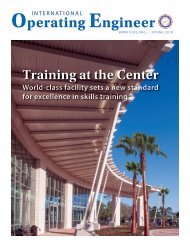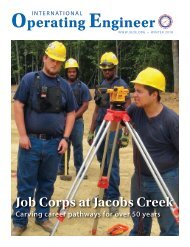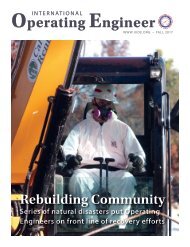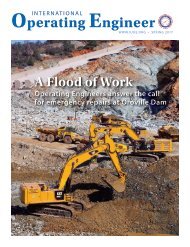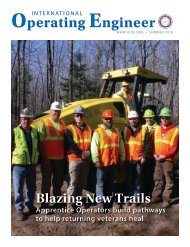International Operating Engineer - Winter 2017
The quarterly magazine of the International Union of Operating Engineers.
The quarterly magazine of the International Union of Operating Engineers.
Create successful ePaper yourself
Turn your PDF publications into a flip-book with our unique Google optimized e-Paper software.
HAZMAT<br />
OSHA estimates that the<br />
proposed rule will prevent<br />
96 premature deaths each<br />
year and prevent 50 new<br />
cases of CBD per year, once<br />
the full effects of the rule<br />
are realized.<br />
OSHA Issues New Beryllium Standards<br />
THE OCCUPATIONAL SAFETY<br />
and Health Administration (OSHA)<br />
has issued new standards for General<br />
Industry, Construction, and Shipyards<br />
for the prevention of chronic beryllium<br />
disease and lung cancer in American<br />
workers. About 62,000 workers<br />
are exposed to beryllium in their<br />
workplaces.<br />
The majority of workers exposed<br />
are in General Industry operations<br />
such as beryllium metal and ceramic<br />
production, non-ferrous foundries, and<br />
fabrication of beryllium alloy products.<br />
Approximately 11,500 Construction and<br />
shipyard workers are exposed who may<br />
conduct abrasive blasting operations<br />
using slags that contain trace amounts<br />
of beryllium.<br />
Key provisions of these rules are: (1)<br />
reduces the permissible exposure limit<br />
(PEL) for beryllium to 0.2 micrograms<br />
per cubic meter of air, averaged over<br />
8-hour workday, and (2) establishes<br />
short term exposure limit (STEL) of 2.0<br />
micrograms per cubic meter of air, over<br />
a 15-minute sampling period.<br />
Employers are required to:<br />
• Use engineering and work practice<br />
controls (such as ventilation<br />
or enclosures) to limit worker<br />
exposure to beryllium;<br />
• Provide respirators when controls<br />
cannot adequately limit exposure;<br />
• Limit worker access to highexposure<br />
areas;<br />
• Develop a written exposure<br />
control plan;<br />
• Train workers on beryllium<br />
hazards; and<br />
• Make available medical exams<br />
to monitor exposed workers<br />
and provide medical removal<br />
protection benefits to workers<br />
identified with a beryllium-related<br />
disease.<br />
Both the General Industry 1910.1024<br />
and Construction Industry 1926.1124<br />
standards are similar, but there are<br />
industry-specific elements addressed<br />
within each standard which include:<br />
• Competent person designation -<br />
1926.<br />
• Hygiene areas and practices<br />
(showers) - 1926.<br />
• Communication of hazards - 1910<br />
• Disposal of contaminated material<br />
- 1910.<br />
• Work areas - 1910.<br />
Compliance to all three standards<br />
will take effect on March 10, <strong>2017</strong>,<br />
after which all three sectors (General<br />
Industry, Construction and Shipyards)<br />
have one year (March 12, 2018) to<br />
comply with most of the requirements.<br />
All sectors have two years (March<br />
11, 2019) from the effective date to<br />
provide any required change rooms<br />
and showers, and three years (March<br />
10, 2020) from the effective date to<br />
implement engineering controls.<br />
Revised Silica Standards Are Released<br />
THE OCCUPATIONAL SAFETY<br />
and Health Administration (OSHA)<br />
has issued two revised standards,<br />
Construction ¬¬1926.1153, and General<br />
Industry and Maritime 1910.1053, to<br />
reduce lung cancer, silicosis, chronic<br />
obstructive pulmonary disease and<br />
kidney disease in workers by limiting<br />
their exposure to respirable crystalline<br />
silica.<br />
About 2.3 million workers are<br />
exposed annually to respirable<br />
crystalline silica in their workplaces.<br />
Over 2 million construction workers<br />
drill, cut, crush, or grind silicacontaining<br />
materials such as concrete<br />
and stone. Approximately 300,000<br />
workers work in general industry<br />
operations such as brick manufacturing,<br />
foundries, and hydraulic fracturing,<br />
also known as fracking.<br />
Provisions to both standards include<br />
the reduction of the permissible<br />
exposure limit (PEL) for respirable<br />
crystalline silica to 50 micrograms per<br />
cubic meter of air, averaged over an<br />
8-hour shift, and requiring medical<br />
exams to monitor highly exposed<br />
workers to provide them information<br />
about their lung health.<br />
Employers are required to:<br />
• Use engineering controls (such<br />
as water or ventilation) to limit<br />
worker exposure to the PEL;<br />
• Provide respirators when<br />
engineering controls cannot<br />
adequately limit exposure;<br />
• Limit worker access to high<br />
exposure areas;<br />
• Develop a written exposure<br />
control plan;<br />
• Offer medical exams to highly<br />
exposed workers; and<br />
• Train workers on silica risks and<br />
how to limit exposures.<br />
In addition, there are industryspecific<br />
requirements including<br />
the establishment of an action level<br />
of 25 micrograms per cubic meter<br />
for workers exposed - 1910; and<br />
establishing specific exposure control<br />
measures when working with materials<br />
containing crystalline silica -1926.<br />
Both standards became effective<br />
June 23, 2016, after which industries<br />
have the following schedule to comply<br />
with most requirements:<br />
• Construction - June 23, <strong>2017</strong>, one<br />
year after the effective date.<br />
• General Industry and Maritime -<br />
June 23, 2018, two years after the<br />
effective date.<br />
• Hydraulic Fracturing - June 23,<br />
2018, two years after the effective<br />
date for all provisions except<br />
<strong>Engineer</strong>ing Controls, which has a<br />
compliance date of June 23, 2021.<br />
<strong>2017</strong> Trainer Course Schedule<br />
The National HAZMAT Program released its <strong>2017</strong> Trainer Course Schedule in December 2016. If you are a trainer and did not<br />
receive an email or need copies of the Enrollment Form or OSHA Pre-requisite Form, please contact the HAZMAT Program at<br />
304-253-8674 or hazmat@iuoehazmat.org.<br />
18 INTERNATIONAL OPERATING ENGINEER<br />
WINTER <strong>2017</strong> 19


